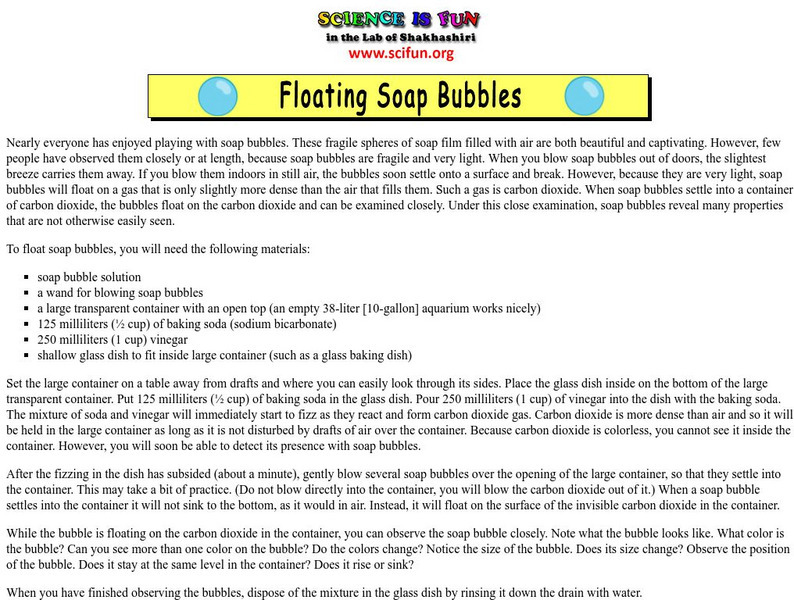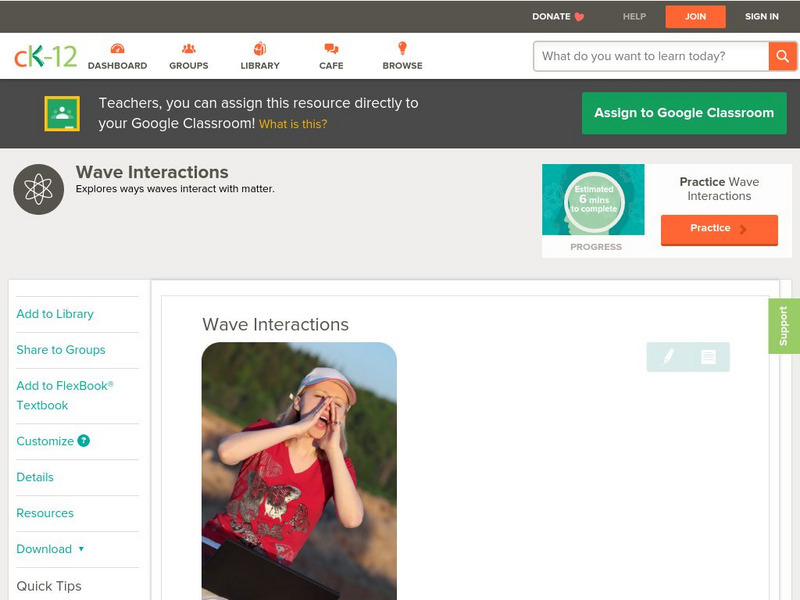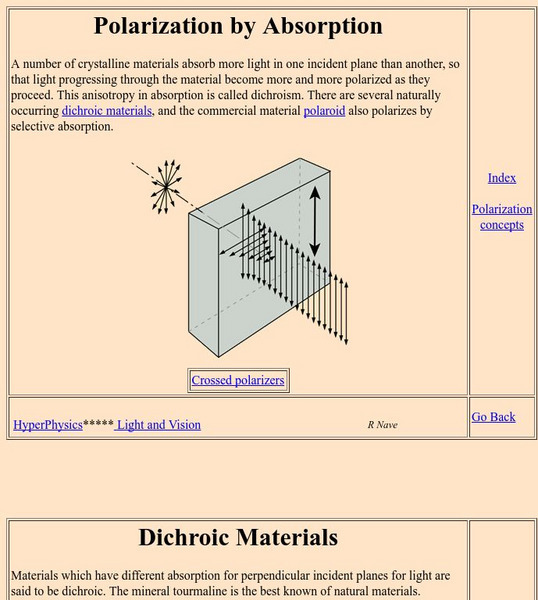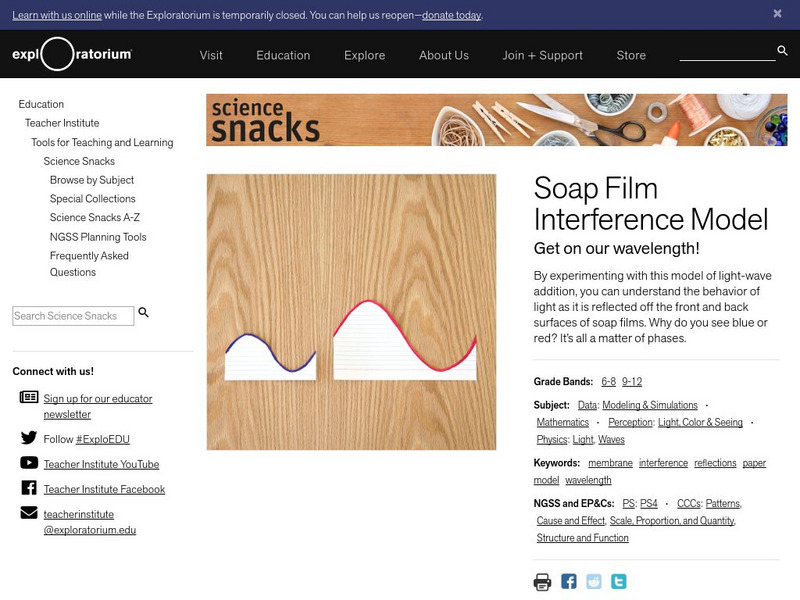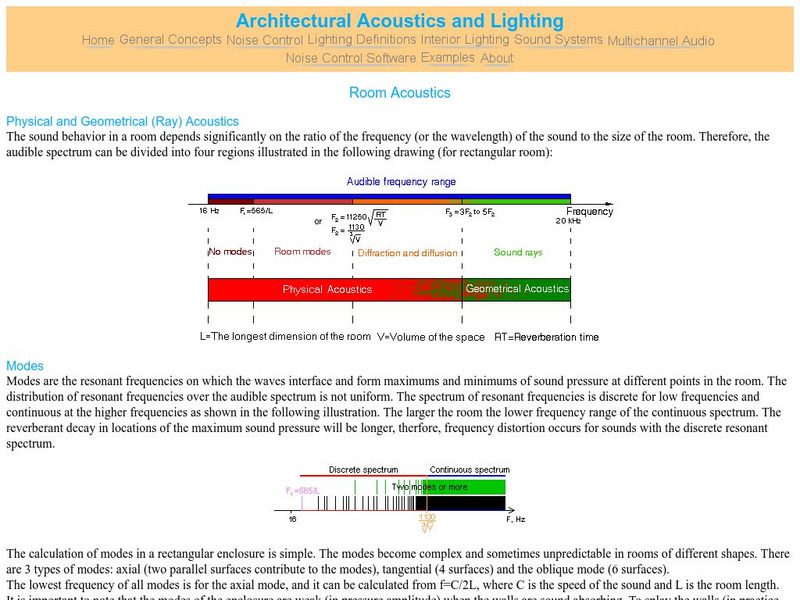TeachEngineering
Teach Engineering: Beating the Motion Sensor
Lighting is responsible for nearly one-third of the electricity use in buildings. One of the best ways to conserve energy is to make sure the lights are turned off when no one is in a room. This process can be automated using motion...
University of Maryland
Optics Highlights: Optics, Electromagnetic Waves, Quanta
Part of an anecdotal history on optics and the study of light. Extremely thorough treatment of the scientific evidence which led scientists to believe in the particle nature of light. Includes a short biographical sketch and discusses...
Mocomi & Anibrain Digital Technologies
Mocomi: What Is Scattering of Light?
Do you know why the sky is blue? Article defines scattering and how it works. Explains the difference between the scattering of light and reflection or refraction.
Ducksters
Ducksters: Physics for Kids: Behavior of Light as a Wave
Kids learn about the behavior of light as a wave in the science of physics including reflection, refraction, and diffraction.
ClassFlow
Class Flow: Introduction Lesson on Light
[Free Registration/Login Required] This flipchart is an introduction lesson on light. It explains absorption, transmission, and reflection. It contains real pictures that allow students to see how matter in an object determines how much...
ClassFlow
Class Flow: Introduction to Light
[Free Registration/Login Required] This flipchart introduces fifth graders to the science of light. Principles such as transparent, translucent, opaque, reflection, and refraction are covered. Concave and convex mirrors and lenses are...
Science is Fun
Science Is Fun: Floating Soap Bubbles
In this experiment you learn how to generate carbon dioxide inside a container, and float soap bubbles above the gas. Once the bubbles are suspended, it is possible to observe them closely, which is normally very difficult to do....
CK-12 Foundation
Ck 12: Physical Science: Wave Interactions
[Free Registration/Login may be required to access all resource tools.] Ways that waves can interact with matter and examples.
CK-12 Foundation
Ck 12: Plix: Wave Interactions: Law of Reflection
[Free Registration/Login Required] Move the light source to see what happens to the reflected ray as you change the angle of the incident ray.
CK-12 Foundation
Ck 12: Plix: Law of Reflection: Angle of Incidence
[Free Registration/Login Required] In the scenario shown here, the laser cannot shine through the black barrier but can hit all three targets by reflecting off of the floor. Use the red dot to change the angle of the laser generator and...
Better Lesson
Better Lesson: Mira Mira the Amazing Mira
Using a mira, 4th graders draw symmetrical pictures and then explain how the mira works using what they know about reflection and the eye.
Exploratorium
Exploratorium: Bubbularium
What colors do you see in a bubble? Why do you see colors in a bubble? Use this site to find out the answer to these questions with this easy experiment.
Georgia State University
Georgia State University: Hyper Physics: Polarization by Absorption
The operation of Polaroid filters on a pair of sunglasses is shown.
Georgia Department of Education
Ga Virtual Learning: Optics
Students discover how mirrors affect optics in this module through reading informational text, watching animations, and answering self-checking practice questions.
Walter Fendt
Walter Fendt: Apps Zur Physik
This site, in German, offers numerous apps that illustrate common physics principles. Apps are organized into categories: mechanics, oscillations and waves, electrodynamics, optics, thermodynamics, the theory of relativity, physics of...
Exploratorium
Exploratorium: Science Snacks: Soap Film Interference Model
In this experiment, students construct models of larger red and smaller blue waves on index cards, and use them to investigate how light behaves when it is reflected off the front and the back of soap film.
Exploratorium
Exploratorium: Science Snacks: Soap Film Painting
Investigate the constructive and destructive interference of waves as they reflect off the front and back surfaces of soap film. See what colorful effects can be created on a large, vertical soap film surface where gravity comes into play.
Other
Architectural Acoustics and Lighting: Room Acoustics
This site from Architectural Acoustics and Lighting provides a discussion of various factors affecting the acoustics of a given room. Room dimensions, the wavelength of the sound wave, the physical characteristics of the walls, the...
Physics Classroom
The Physics Classroom: Polarization
"How Do We Know Light Behaves as a Wave?" An answer is provided in this discussion of the polarization of light and the use of Polaroid filters in sunglasses. The four methods discussed on this page are: polarization by transmission,...
Oklahoma Mesonet
Oklahoma Climatological Survey: Overview of Radiation
This site details what radiation is, the physics of radiation, and radiative transfer as it occurs in nature. Content explores the electromagnetic spectrum, electromagnetic waves, properties of radiation, and solar radiation.
Synopsys
Synopsys: A Gentle Intro to Optical Design: Why Is the Sky Blue?
Discusses Rayleigh scattering in plain language and attributes the blueness of the skies to this phenomenon. Discussion of scattering is just one topic of many on this lengthy page of optical topics.
CK-12 Foundation
Ck 12: Fourth Grade Science
This customizable digital textbook covers topics related to fourth-grade science. It is Next Generation Science Standards (NGSS) aligned.
TeachEngineering
Teach Engineering: Energy
Through nine lessons, students are introduced to a range of energy types--electrical, light, sound and thermal-as well as the renewable energy sources of wind, hydro (water) and solar power. Subjects range from understanding that the...
Exploratorium
Exploratorium: Science Snacks: Water Sphere Lens
Demonstrate for students how a round bowl of water can act as both a magnifier and a lens.







